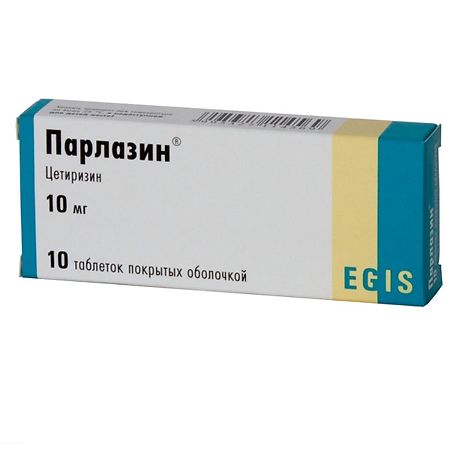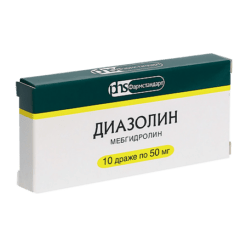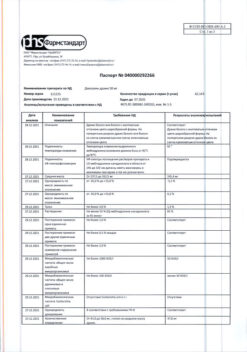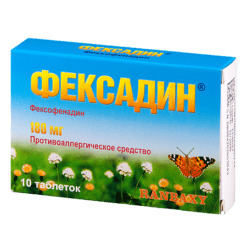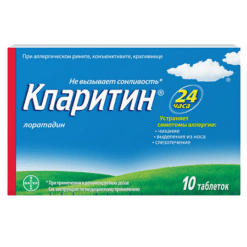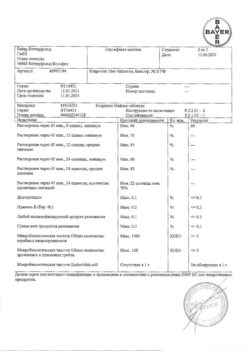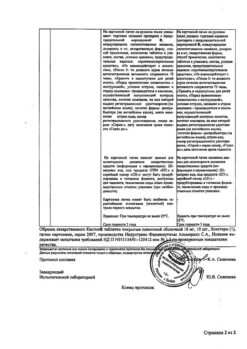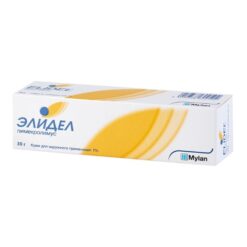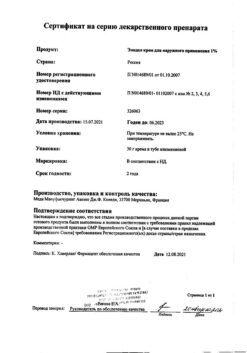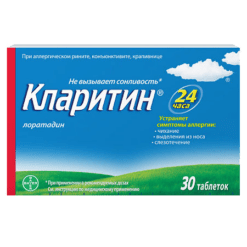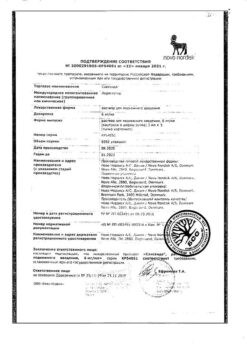No products in the cart.
Description
Parlazine is an anti-allergic agent.
Pharmacodynamics
Cetirizine is a carboxylated metabolite of hydroxyzine, belongs to the class of antihistamine drugs of piperazine derivatives. The action of cetirizine and its antiallergic effects are based on selective blockade of peripheral histamine H1 receptors. By this mechanism, cetirizine suppresses early histamine-mediated allergic reactions, reduces the migration of inflammatory cells and the release of mediators associated with later allergic reactions. Cetirizine has only minor anticholinergic and antiserotoninergic effects.
Indications
Indications
Active ingredient
Active ingredient
Composition
Composition
Active ingredient:
cetirizine dihydrochloride 10 mg;
Excipients:
colloidal anhydrous silica – 0.8 mg;
magnesium stearate – 1.7 mg;
Lactose monohydrate – 11.5 mg;
MCC – 91 mg;
Shell: Opadry Y-1-7000 (hypromellose; titanium dioxide C.I. 77891, macrogol 400) – 4 mg; Ariavit Sunset Yellow C.I. 15985 (Sunset Yellow dye) – 0.01 mg
How to take, the dosage
How to take, the dosage
Ingestion.
The drops are dissolved in a small amount of water before intake.
Adults and adolescents over 12 years of age: 10 mg (20 drops or 1 tablet) once daily, preferably at bedtime.
Children aged 6-12 years: 5 mg (10 drops or 1/2 tablet) twice daily (morning and evening) or 10 mg (20 drops or 1 whole tablet) in the evening.
In children aged 1-6 years, we recommend that Parlazine® be prescribed in the oral drop form.
Children aged 2-6 years: 5 mg (10 drops) once. It is also possible to divide this dose into 2 doses of 2.5 mg (5 drops in the morning and evening).
Children aged 1-2 years: 2.5 mg (5 drops) 2 times a day.
Special Instructions
Special Instructions
In case of hypersensitivity reactions, the drug should be stopped immediately.
Kidney disease. Due to decreased excretion rate of cetirizine it may accumulate in patients with impaired renal function; in this case the frequency and severity of anticholinergic side effects or effects on the CNS may increase, even in case of taking the usual dose for adults. Therefore, in such cases it is recommended to reduce the dose.
Elderly patients are particularly sensitive to the anticholinergic effects of antihistamines (e.g., dry mouth, urinary retention). If these side effects are observed for a long time, and if their intensity increases, the drug should be discontinued. Although cetirizine is less likely to cause anticholinergic side effects or severe CNS side effects, it can accumulate (age-related decreased renal function is more likely in elderly patients) and cause anticholinergic side effects or CNS side effects even when administered at the usual dose for adults.
Coated tablets contain lactose, therefore this drug should not be administered to patients with lactose intolerance and/or glucose-galactose malabsorption syndrome.
Skin tests:
the use of Parlazine should be stopped at least 3 days before the allergic skin test in order to avoid false-negative results.
Contraindications
Contraindications
With caution: the drug is indicated in moderate to severe chronic renal failure (dosage regimen adjustment is required) and in elderly patients (dosage regimen adjustment is required).
Overdose
Overdose
Symptoms (at a single dose of 50 mg): confusion, dizziness, headache, increased fatigue, weakness, malaise, sedation, drowsiness, stupor, mydriasis, pruritus, tremor, diarrhea, urinary retention.
Treatment: gastric lavage, provocation of vomiting; intake of activated charcoal, symptomatic and supportive therapy. There is no specific antidote. Hemodialysis is ineffective.
Similarities
Similarities
Additional information
| Shelf life | 4 years |
|---|---|
| Conditions of storage | At a temperature not exceeding 25 °C |
| Manufacturer | EGIS, Hungary |
| Medication form | pills |
| Brand | EGIS |
Related products
Buy Parlazine, 10 mg 10 pcs. with delivery to USA, UK, Europe and over 120 other countries.

